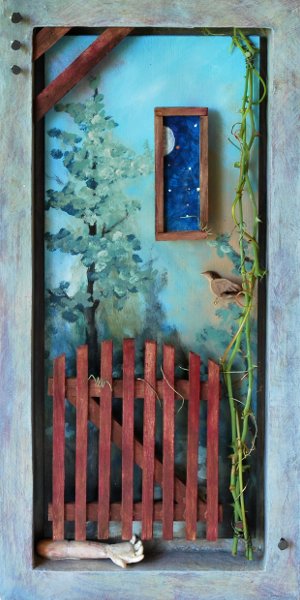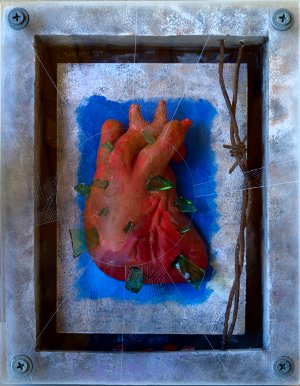
“The Triumph of the Nightingale” – mixed media, 7 x 14 in (17.5 x 35 cm).
In spite of my head cold, trips to the vet, money woes, and general malaise over the last couple of weeks, I did manage to get two new pieces of artwork done.
One is a fairly whimsical intellectual exercise, a “sequel” to the Max Ernst painting of 1924, “Two Children are Threatened by a Nightingale“. My take on the theme — called “The Triumph of the Nightingale” — reuses several elements from the Ernst painting, such as the garden gate, a suggestion of the peaked roof of the little shed, and the flying bird, but condenses everything down into a vertical format, and folds all the pieces together more tightly. Ernst’s panic-stricken children are reduced in my work to a single body part.
Someone familiar with the original will almost certainly get the connection; someone who has not seen the Ernst painting can still appreciate the visual appeal of my picture, and perhaps enjoy wondering what it all means.
At least that was the theory: in practice, this work has not really gotten much traction with anyone. I don’t know what the problem is, really: is it too “pretty”? Too obscure? Too sterile? Too hermetic?
This sort of problem is not unique to art: when my friends make comments about sporting events, they often use language that is, for them, a convenient and accessible shorthand, but which for me is completely meaningless. They are so immersed in their context that they are not able to objectively assess the reach of that context — a creature born and bred in the deep ocean may easily forget that some organisms live entirely in open air. Likewise, my knowledge of art and literature can be a handicap when I’m looking for universal themes, since what I believe to be universal may only be so within a defined intellectual or cultural environment.
On the heels of that debacle, the next piece was an assemblage dealing with the idea of grief — drawing on my upset over the death of my cat Sebastian — called “Niobe”. In the story, the queen Niobe has a brood of beautiful, talented children whom she adores so much that she proclaims to one and all that they are even more wonderful than the twin children of Leto, Artemis and Apollo. Comparing your offspring to those of the gods is always a recipe for disaster in classical literature, and this instance is no exception: Artemis and Apollo are sent to teach Niobe a lesson in humility, and they do so by killing her children; one by one her sons and daughters die in her arms.

“Niobe” – mixed media, 7 x 9 inches (17.5 x 22.5 cm)
To illustrate the theme, I modeled a realistic human heart, studded with shards of glass, reducing the concept to its most visceral (pardon the pun) and physical level.
Here again, the piece failed to take hold with my usual fans. I did get some very positive responses from Mexican friends, who saw a parallel with the pierced heart that symbolizes the Virgin in much religious art in Mexico and Central America — they understood what I was doing immediately, and connected readily with what was, for them, a familiar image. Context made all the difference: a North American audience who sees a naked human heart as the stuff of horror films experiences something completely different than Latin American viewers familiar with the stark but comforting images of the wounded Immaculate Heart of Mary.
This is not a case of relying on a story that was not familiar enough; I think the image speaks for itself even without the context of the myth. Unfortunately the message varies widely from person to person.
Like riding a unicycle along a tightrope, constant forward motion is essential in what I do. If I hesitate, if I stop to think for too long, I tumble off the wire. I have to keep working even if what I’m producing is not succeeding, because it’s all too easy to let my native laziness take over if I give it any excuse at all. Finish one piece, start the next; if I get bogged down, set that one aside, move on to another. Introspection and contemplation — like what I’m doing here — are fine, but only so long as I can do them without coming down off the wire.
I’m not unhappy with these two pieces of work. They did what I wanted them to do, they feel right, they just don’t resonate well with the world outside my head. I’ll take note, and perhaps this experience will influence the next piece, or the next. More importantly, however, I will keep pedaling, and stay on that tightrope a little longer, and see what happens next.
* * *
Leave a Reply